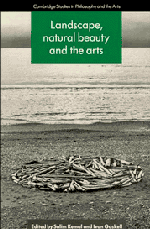Book contents
- Frontmatter
- Contents
- List of contributors
- Editors' acknowledgments
- 1 Nature, fine arts, and aesthetics
- 2 Natural beauty without metaphysics
- 3 Trivial and serious in aesthetic appreciation of nature
- 4 The public prospect and the private view: the politics of taste in eighteenth-century Britain
- 5 Landscape in the cinema: the rhythms of the world and the camera
- 6 The touch of landscape
- 7 Desert and ice: ambivalent aesthetics
- 8 Gardens, earthworks, and environmental art
- 9 Comparing natural and artistic beauty
- 10 Appreciating art and appreciating nature
- 11 The aesthetics of art and nature
- 12 On being moved by nature: between religion and natural history
- Index
7 - Desert and ice: ambivalent aesthetics
Published online by Cambridge University Press: 03 May 2011
- Frontmatter
- Contents
- List of contributors
- Editors' acknowledgments
- 1 Nature, fine arts, and aesthetics
- 2 Natural beauty without metaphysics
- 3 Trivial and serious in aesthetic appreciation of nature
- 4 The public prospect and the private view: the politics of taste in eighteenth-century Britain
- 5 Landscape in the cinema: the rhythms of the world and the camera
- 6 The touch of landscape
- 7 Desert and ice: ambivalent aesthetics
- 8 Gardens, earthworks, and environmental art
- 9 Comparing natural and artistic beauty
- 10 Appreciating art and appreciating nature
- 11 The aesthetics of art and nature
- 12 On being moved by nature: between religion and natural history
- Index
Summary
The water-scarce (desert) and frigid (ice) regions are among the earth's harshest environments. A glance at any world-population map shows that these are the “empty quarters” which for long have successfully resisted the human imprint. Attitudes to these environments by people who have settled in the more accommodating, kindly parts of the earth have been complex and deeply ambivalent: we find instances of indifference and deliberate neglect, or, at the other extreme, keen interest as potential economic resource and base of political power; we find desert and ice viewed as threatening presences to be conquered in the name of national pride and manhood, or as challenge to the prowess of science; and last, though certainly not least, we find worshipful admiration tinged by fear. It is this last attitude that I should like to explore. To do so, I need a point of departure and conceptual frame. Home is the point of departure for real as well as figurative explorations. I will therefore start with the concept of home.
Love of home is universal, whether this be rain forest, dry boundless plain, or tundra. How is it possible for humans to differ so greatly in the environment they prefer? Although the larger environments differ strikingly in character, the places where people actually spend most of their time, sleep, and eat can have much in common. Home is not a simple entity.
- Type
- Chapter
- Information
- Landscape, Natural Beauty and the Arts , pp. 139 - 157Publisher: Cambridge University PressPrint publication year: 1993
- 5
- Cited by



